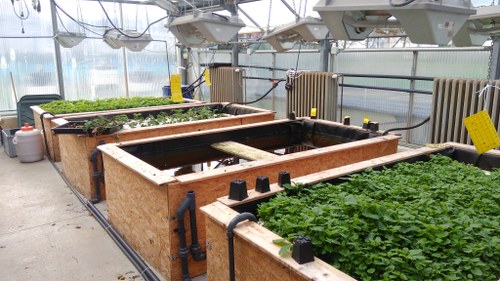Case study of technological innovations: Protected climate-controlled aquaponics system.

Location: Soest, Germany
Typology: Protected aquaponics
Urban area: Urban
Innovation type: Technological innovation
Main functions: Water recirculation – Polyculture – Research
The aquaponics system at SWUAS (Fachbereich Agrarwirtschaft der Fachhochschule Südwestfalen) was implemented for research purposes. The installation started in May 2015. Regarding the aquaculture system, European catfish are held in three 1.1 cubic meter tanks, equipped with filters, feeders and warm water. The fish production is connected to the floating hydroponic system hosted in the greenhouse next door, growing in deep water culture beds (DWC). Aquaponics seeks for resource efficiency by recirculating the water between the two systems: the water from fish farming (aquaculture) flows into the plant basins (hydroponics) where the fish residues are used as fertilizers.
Crops: Lettuce (Salanova cook RZ), Lemon balm and Basil (African blue)
Fish: European catfish (Silurus glanis)
Techniques: Aquaponics production: Aquaculture tanks with UV disinfection and filters (biological & mechanical) + Floating hydroponic production with wooden beds
Irrigation: Well water (Elevated amount of calcium carbonate)– Recirculation – Automatic irrigation (Tap water is available)
Use of renewable resources: –
Sustainable practices: Pesticides-free – Integrated pest management – Local production – Minimization of water consumption – Sustainable production of protein sources
Other products: –
Sanyé-Mengual, E., Specht, K., Grapsa, E., Orsini, F., & Gianquinto, G. (2019). How Can Innovation in Urban Agriculture Contribute to Sustainability? A Characterization and Evaluation Study from Five Western European Cities. Sustainability, 11(15), 4221.
Calone, R., Pennisi, G., Morgenstern, R., Sanyé-Mengual, E., Lorleberg, W., Dapprich, P., ... & Gianquinto, G. (2019). Improving water management in European catfish recirculating aquaculture systems through catfish-lettuce aquaponics. Science of the total environment, 687, 759-767.